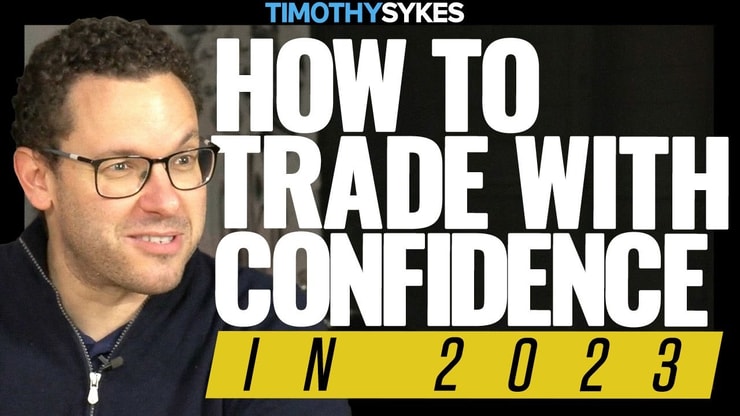The MACD indicator is a momentum oscillator used to trade trends. It stands for Moving Average Convergence/Divergence, and is calculated by subtracting the 26-period Exponential Moving Average (EMA) from the 12-period EMA. It consists of two lines that ebb and flow alongside the stock’s price action.
We’ll go through the basics in a bit. But first, understand that successful trading necessitates the use of indicators.
I’ve been in the industry for over 20 years and I’ve never met a successful trader that solely relies on the MACD.
If you’re willing to use the MACD in conjunction with other tools, you’ve got the right mindset.
And the good news is, there are a lot of indicators to choose from. Even better, I’ve been where you are and I can help understand this finance jargon.
My college degree is in philosophy …
I used to be a confused newbie and I had to teach myself.
Now I’m a trading veteran with over $7.4 million in profits and over 30 millionaire students.
Apply for my Trading Challenge today.
Let’s get started …
Table of Contents
- 1 What Is the MACD Indicator?
- 2 How Does the MACD Indicator Work?
- 3 Ways to Interpret the MACD Index
- 4 How to Use the MACD Indicator for Trading
- 5 Common Mistakes. How NOT to Use the MACD Indicator
- 6 Key Takeaways
- 7 Frequently Asked Questions
- 7.1 When Is the Best Time to Use MACD?
- 7.2 Which Are the Best MACD Indicator Settings?
- 7.3 Can the MACD Indicator Be Adapted for Different Market Types?
- 7.4 What Is the MACD Indicator and How Does It Work?
- 7.5 What Is the Importance of the MACD Line in MACD Analysis?
- 7.6 What Resources Are Available for Beginners To Learn About the MACD Indicator?
- 7.7 How Can Traders Use the MACD in Stock and Forex Trading?
- 7.8 How Is the MACD Indicator Useful in Identifying Price Trends and Potential Reversals?
- 7.9 What Should I Consider When Using the MACD Indicator in My Trading Strategy?
- 7.10 How Can Beginners Start Using the MACD Indicator?
What Is the MACD Indicator?

2025 Millionaire Media, LLCThe MACD indicator is a momentum oscillator based on moving averages for different time frames. It’s an indicator that many traders use to identify emerging trends.
We’re not here to play guessing games; we’re here to decipher patterns and make strategic moves. One tool that helps us do that is the MACD Indicator.
You could say it puts us in a better position to trade.
Understanding the MACD Indicator and its significance is the first step, but it’s also important to know how it fits into the broader landscape of day trading indicators. We’ve got to digest this data on a broader scale.
There’s a wide range of tools that traders use to make informed decisions, and the MACD is just one of them.
To get a more comprehensive view, consider exploring other day trading indicators. That link has some great examples and it will give you a more holistic understanding of the tools at your disposal.
The Basics of the MACD Indicator
The MACD indicator, at its core, is a momentum oscillator.
It’s founded on the relationship between two moving averages of a security’s price.
It derives its value by subtracting the 26-period Exponential Moving Average (EMA) from the 12-period EMA.
A 9-day EMA, its name is the ‘signal line,’ is then plotted on top of the MACD to function as a trigger for a trade signal. Signal lines are an essential aspect of this tool.

Demystifying the MACD Indicator Step by Step
Unraveling the MACD indicator, you find three key components: the MACD line, the signal line, and the histogram.
The MACD line is the difference between the short-term EMA (12-period) and the long-term EMA (26-period).
By contrast, the signal line is the 9-day EMA of the MACD line.
The histogram is a visual representation of the difference between the MACD and the signal line.
By understanding each component’s role, traders can make informed decisions based on the indicator’s signals. The result is higher trend awareness.
How Does the MACD Indicator Work?
Knowing what the MACD Indicator is paves the way to understanding how it works. Stick with me here, it’s not as complex as it sounds.
The MACD Indicator is a powerful tool, but it’s not the only one that can help you in your trading journey.
For instance, the Momentum Indicator is another valuable tool that can provide insights into the speed of price change. By understanding how to use both, you can make more informed trading decisions. Learn more about the Momentum Indicator to expand your trading toolkit.
I’ll also include the top indicator I use to find new spikers …
Utilizing multiple indicators will increase our trade confirmation.
More Breaking News
- Vale Stock Takes a Dip: What’s Next?
- BULL Anticipates Strong FY Earnings Amid Strategic Moves
- Bit Digital’s New Ethereum Focus: Game-Changer?
MACD Settings and Setup
The MACD’s standard settings and setup is 12-26-9, denoting the periods for the EMAs and the signal line. However, depending on the market type and the trading style, these parameters can be tweaked.
For example, my specialty is trading volatile low-priced stocks. And that’s what I teach to my students. These trades happen quickly, so you might want to set MACD to better reflect short-term trends.
I rely on StocksToTrade for my trading software. I helped develop it to specifically meet the needs of a small-account day trader.
I used to need tons of tabs open just to make a trade. Now it’s all in one place.
Here’s a 14-day StocksToTrade trial, just $7!
Once set, the MACD and signal line will hover around a zero line, their crossovers marking potential trading signals.
Ways to Interpret the MACD Index

2025 Millionaire Media, LLCArmed with understanding, we can now turn to interpret the signals given by the MACD Index.
Interpreting the MACD Index is a skill that comes with practice and understanding.
But remember, the MACD settings can also play a crucial role in your interpretation. Different settings can provide different insights, so it’s important to understand the best ones for your trading style.
Check out this guide on the best MACD settings to optimize your use of the MACD Indicator.
Key MACD Indicators to Watch
To fully harness the power of the MACD, keep an eye on three key indicators …
- Crossovers
- Divergence
- Dramatic rise
A crossover occurs when the MACD line crosses the signal line, this situation is a potential sign to buy or sell. Divergence between the MACD and price signals a possible trend reversal.
A dramatic rise in the MACD may indicate the asset is overbought and due for a price correction.
It’s always good to remember a possible reversal after extremes.
How to Use the MACD Indicator for Trading
Armed with this knowledge, let’s discuss how we can employ this tool for actual trading scenarios.
You won’t often see MACD used by investors, so if you’re looking to save for retirement, consider a mutual fund.
We’re here to capitalize off volatile price movements in a short period of time.
Luckily, that’s what I do best. Watch my video below for key tips in 2023 …
What Is the Best Time Frame for MACD?
MACD can be applied across a series of time frames, from day trading to long-term analysis.
However, its effectiveness largely depends on the person and their individual trading strategies and goals. Some might find it beneficial on a short-term basis, while others might use it for longer trends.
It might also be beneficial to view it in multiple time frames. This is similar to how traders watch multiple time frames for a price chart. It’s like condensing the calendar to see larger trends.
How to Use MACD in Crypto Trading
Crypto trading is like navigating a ship in stormy waters.
The MACD Indicator, however, can provide valuable guidance. I hope those words inspired some calmness within you.
Remember, it’s not about belief; it’s about reading the patterns. MACD helps identify potential trend reversals and momentum, two key aspects in the volatile crypto market.
Adapting the Indicator to Crypto Market Volatility
The dynamic nature of the crypto market means that you need to adapt your tools accordingly.
Notice, the MACD Indicator is no exception. By adjusting the settings to reflect the higher volatility, the MACD Indicator can become a reliable tool even in the erratic world of crypto.
Combining MACD With Other Technical Indicators
No tool is perfect.
And even in this case, the MACD Indicator, while powerful, should be used in conjunction with other technical indicators. Consider using it alongside the RSI or Bollinger Bands to help validate the signals it provides and enhance your stock trading strategy.
Common Mistakes. How NOT to Use the MACD Indicator
The MACD is not a magic wand that guarantees profits.
If that’s what you’re looking for, you can exit out of this page.
A common pitfall is relying solely on the MACD without considering the overall market conditions. Also, it’s critical not to misinterpret a false positive crossover, which can lead to ill-timed trades.
Lastly, remember that the MACD is a lagging indicator, meaning it follows price movements. It should be used as a part of a comprehensive trading strategy, not a standalone guide.
Key Takeaways

2025 Millionaire Media, LLCIn conclusion, when it comes to technical analysis, the MACD Indicator is a tried and tested tool.
Its strength lies in its ability to signal potential buy and sell opportunities, helping traders like you and me make informed decisions.
Trading isn’t rocket science. It’s a skill you build and work on like any other. Trading has changed my life, and I think this way of life should be open to more people…
I’ve built my Trading Challenge to pass on the things I had to learn for myself. It’s the kind of community that I wish I had when I was starting out.
We don’t accept everyone. If you’re up for the challenge — I want to hear from you.
Apply to the Trading Challenge here.
Trading is a battlefield. The more knowledge you have, the better prepared you’ll be.
What indicators do you use to trade? Let me know in the comments — I love hearing from my readers!
Frequently Asked Questions
When Is the Best Time to Use MACD?
The MACD shines in trending markets, helping identify potential entry and exit points.
But the ‘best time’ varies as per the asset and market volatility. Whether it’s a daily timeframe for a less risky approach, or shorter intervals for more frequent trades, the choice hinges on your trading style and risk tolerance.
Which Are the Best MACD Indicator Settings?
There’s no one-size-fits-all when it comes to MACD settings. In this article we discussed a few.
The “best” settings depend on your trading style, risk tolerance, and the specific market conditions.
Can the MACD Indicator Be Adapted for Different Market Types?
The MACD Indicator can be adapted to different markets by adjusting the parameters.
Whether you’re trading stocks or cryptocurrencies, the MACD can be a crucial ally. Remember, it’s all about reading the patterns, not believing in stocks.
What Is the MACD Indicator and How Does It Work?
The MACD, or Moving Average Convergence Divergence, is a trading indicator used in technical analysis of stock prices.
It is designed to reveal changes in the strength, direction, momentum, and duration of a trend in a stock’s price.
It’s represented on a chart and comprises two lines: the MACD line, which is the difference between the 12-period EMA and the 26-period EMA, and the signal line, a 9-day EMA of the MACD line. The blue line is typically the MACD line.
Divergences, crossovers, and extreme values are some of the methods traders use to interpret the MACD.
What Is the Importance of the MACD Line in MACD Analysis?
When analyzing the Moving Average Convergence Divergence (MACD), the blue line, or the MACD line, plays a significant role.
It’s essentially a representation of the difference between two Exponential Moving Averages (EMAs) of different periods. It charts the highs and lows, allowing traders to see the price changes and the underlying momentum.
By paying attention to where the MACD line is in relation to the signal line and the zero line, you can identify potential buy signals or sell signals. When the top line crosses to the bottom that’s a hint to act.
Remember, the MACD is just a tool, not a crystal ball. Always consider other factors such as news events and overall market conditions for comprehensive analysis.
The market doesn’t hand people profits. It takes a bit of effort to make money. But nothing worth having ever came easy.
What Resources Are Available for Beginners To Learn About the MACD Indicator?
Beginners looking to understand the MACD indicator can refer to trading courses, online tutorials, informational content on financial websites, and even the advice of experienced traders.
Also, clients of a broker can open a demo account to practice using the MACD in a risk-free environment.
The StocksToTrade menu offers traders the chance to test strategies with a paper trading account. The software has a ton of services conducive to my niche and trading style.
Remember, while the MACD can provide valuable insight, it also comes with risks, especially if used without a good understanding of its limitations.
How Can Traders Use the MACD in Stock and Forex Trading?
Traders use the MACD to identify potential buy and sell signals.
When the MACD line crosses above the signal line, it could be a bullish (buy) signal. If the MACD line crosses below the signal line, it could be a bearish (sell) signal. Traders also watch for divergences between the MACD and price action as a sign of an impending trend reversal.
In forex trading, the MACD is also popular due to its ability to work well across different time frames.
However, it’s crucial for traders to consider other aspects of the market trend and not rely solely on the MACD.
How Is the MACD Indicator Useful in Identifying Price Trends and Potential Reversals?
The MACD (Moving Average Convergence Divergence) is a highly versatile tool widely used in forex trading and the stock market.
It helps traders identify the direction of price trends (uptrend or downtrend) and potential reversals by comparing the relationship between two moving averages of a security’s price.
When the MACD line (calculated by subtracting the 26-period Exponential Moving Average from the 12-period EMA) crosses above the signal line (the 9-period EMA of the MACD line), it’s typically seen as a bullish signal, suggesting an uptrend.
Conversely, when the MACD line crosses below the signal line, it might suggest a bearish signal or a downtrend. This crossing of lines, known as a signal line crossover, is one way to interpret the MACD.
Moreover, traders look at the MACD histogram for insights. Those are the bars on the indicator’s graph.
The MACD histogram plots the distance between the MACD line and the signal line, and can provide a visual representation of the speed of price movement.
Peaks and troughs on the histogram can provide additional information about the strength of the trend and potential reversals.
What Should I Consider When Using the MACD Indicator in My Trading Strategy?
When using the MACD indicator, it’s crucial to keep in mind that while it’s a powerful tool, it doesn’t provide a full picture of the market on its own.
MACD is best used in conjunction with other indicators and methods of analysis.
For example, combining MACD with support and resistance levels can provide better insight into potential entry and exit points.
Furthermore, MACD can sometimes give false signals, particularly in choppy or flat markets.
Hence, understanding market conditions and applying risk management strategies, such as setting stop losses, is essential. Also, it’s always recommended to use the MACD indicator as part of a well-rounded trading strategy, keeping in mind your individual risk tolerance and financial goals.
How Can Beginners Start Using the MACD Indicator?
For beginners, getting started with the MACD indicator might seem complex, but with practice and patience, it can become a valuable part of your trading toolkit.
First, familiarize yourself with the basic components of the MACD — the MACD line, the signal line, and the histogram.
Understanding what each represents and how they interact with each other is crucial.
Then, learn about the key concepts such as signal line crossovers, bullish and bearish divergences, and overbought and oversold conditions. Many trading platforms offer educational content and resources to help you understand these concepts.
Remember, the goal is to use the MACD to spot potential trading opportunities and make informed decisions, not to predict the market. Always use it in conjunction with other analysis methods and never risk more than you can afford to lose.
Lastly, it might be beneficial to start by paper trading or using a demo account to practice using the MACD without risking real money. Over time, you will gain experience and learn how to use the MACD effectively in your trading strategy.










Leave a reply